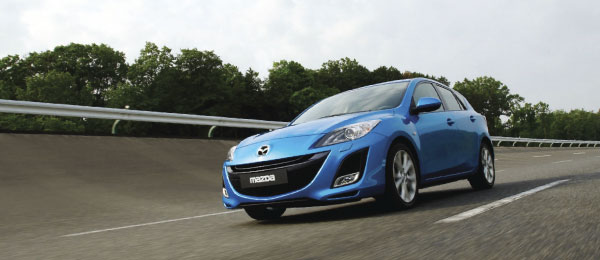Global Logistics—March 2010

CEVA Goes Zoom Zoom
Mazda has signed a three-year agreement with Dutch 3PL CEVA Logistics to manage spare parts distribution throughout Italy. CEVA collects parts daily from the automobile manufacturer’s warehouse in Klagenfurt, Austria, and transports them to its DC outside Bologna. The 3PL sorts and distributes an estimated 120,000 packages to 140 Mazda dealers and repair shops across Italy every year, as well as manages the handling and processing of returns, including collecting parts from dealers and shipping them to the Austria warehouse.
Setting Green Standards
At its most recent annual meeting, The World Economic Forum’s Logistics & Transport Industry Group, in collaboration with Accenture, agreed to standard guidelines for calculating consignment-level carbon emissions from logistics and shipping operations. The benchmarks will help consumers and businesses assess the carbon impact of transporting products and drive carbon efficiency in the freight and logistics sector. Guidelines also include principles for defining the scope of reportable emissions and how these emissions should be allocated in cases such as shared transport or backhaul.
Damco Debuts in Djibouti
Djibouti is making a new name for itself—and that’s saying something. The country, situated on East Africa’s "horn," has become a trendy distribution hub for East-West trade between Europe, the Middle East, and Asia. It’s why third-party logistics provider Damco recently located a new office there to better manage import/export demand for the region—which is further accentuated by the country’s status as a free-trade zone. As a gateway into the African continent, Damco expects its presence will help spur more economic development and trade opportunities. Ethiopia, for example, is an emerging bed for the floriculture industry, which requires specialized transportation. Previously, flowers had to be airlifted to global markets; but now businesses can contract with Damco to run reefer containers via land through Djibouti and transport them by water around the world.
Shaping a European "Union"
In an effort to stimulate innovation and nurture transportation infrastructure investment and development, a consortium of 17 European businesses have joined forces to create the Hinterport initiative. The partnership, spearheaded by Interporto Bologna, an Italian "freight village," or inland port, intends to share best practices, standardize processes, and build a more complete intermodal transport network throughout Europe. Empowered by the European Union’s Marco Polo funding program, which earmarks investment for infrastructure projects that shift freight off congested roadways, Hinterport’s members include research institutes, port terminal operators and authorities, freight villages, and transport operators.
Cargo Codesharing
Following Lufthansa Cargo’s acquisition of Austrian Airlines, the two carriers have agreed to step up cooperation and optimize cargo flows through their respective hubs in Frankfurt, Munich, and Vienna. The partnership also merges and harmonizes global distribution and freight handling activities, product portfolios, and production processes. In the future, both airlines expect to jointly route and boost cargo traffic through Vienna, with the expectation of making it a central European hub for air freight. The move comes as Lufthansa Cargo confronts night flight restrictions in Frankfurt that threaten future expansion plans.
South Africa’s Roadblock
Even Africa’s most progressive economy is lacking when it comes to transportation and logistics development. South Africa is hamstrung by poor infrastructure and high costs, largely because it is so reliant on over-the-road transport, suggests a new report by Frost & Sullivan. While motor freight dependency can result in more efficient and direct service, it also increases road use, congestion, costs, and infrastructure damage. This modal imbalance is particularly striking in a country with an abundance of raw material sources ideal for rail/intermodal transport. Currently, 80 percent of companies move less than 10 percent of their goods by rail. If adequate rail capacity were available, 46 percent of South African companies could move more than 20 percent of their goods by rail. Consequently, businesses are subjected to needless costs and competitive pressures, while governments elsewhere provide infrastructure and trade incentives to business as a key strategic priority.
America’s Pains, Mexico’s Gains
Government officials in Mexico are likely to raise its three-percent economic growth estimate for 2010 as a result of a stronger-than-expected rebound in manufacturing and an improvement in domestic demand. Independent forecasts from the International Monetary Fund and JPMorgan have recalculated the country’s GDP growth forecast to 4.5 percent. While the U.S. automotive industry has been decimated by slack consumption, shrinking credit, and offshore manufacturing, Mexico reports positive manufacturing growth, with auto industry production more than doubling from January 2009, and exports similarly surging.
Asian Air Freight to Take Off
Airlines in the Asia-Pacific region are forecast to acquire 8,000 new passenger and cargo aircraft, valued at US $1.2 trillion, over the next 20 years, according to Airbus.
Broadly, this represents one-third of global aircraft deliveries between now and 2028, with the region driving demand for larger aircraft types. Consequently, Airbus estimates that Asia-Pacific cargo traffic will increase by 6.3 percent per year, compared with a global average of 5.2 percent. From a freight perspective, this prediction suggests Asian manufacturing potential for, and consumption of, high-value goods will continue to expand.
Ryder Goes East
Ryder System has established a joint venture with Cargo Services Far East Ltd., an Asia-based logistics solutions provider, to offer end-to-end logistics services to North American companies importing goods from Asia. The partnership will help U.S. importers design, plan, and manage product flows from Asian factories to North American retail stores.
Operating as Ryder Supply Chain Solutions Asia, the joint venture provides vendor and purchase order management, inland transport services, export consolidation, and order fulfillment services.
The partnership also builds on Ryder’s recent acquisition of CRSA Logistics, which manages transpacific end-to-end transportation and supply chain services for Canadian retailers, including consolidation services in key Asian hubs and deconsolidation operations in Canada.
